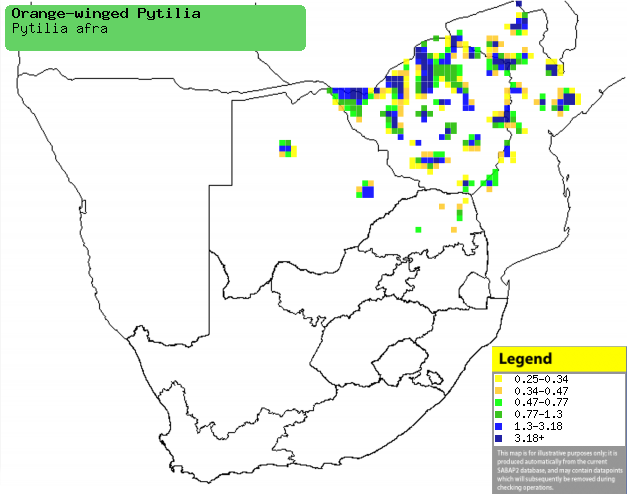|
Pytilia afra (Orange-winged
pytilia, Golden-backed pytilia)
Geelrugmelba [Afrikaans]; Oranjevlerkmelba [Afrikaans];
Matemate (generic term for pytilias) [Kwangali]; Wenerastrild [Dutch];
Beaumarquet à dos jaune [French]; Wiener astrild [German];
Maracachão-d'asa-dourada [Portuguese]
Life
> Eukaryotes >
Opisthokonta
> Metazoa (animals) >
Bilateria >
Deuterostomia > Chordata >
Craniata > Vertebrata (vertebrates) > Gnathostomata (jawed
vertebrates) > Teleostomi (teleost fish) > Osteichthyes (bony fish) > Class:
Sarcopterygii (lobe-finned
fish) > Stegocephalia (terrestrial
vertebrates) > Tetrapoda
(four-legged vertebrates) > Reptiliomorpha > Amniota >
Reptilia (reptiles) >
Romeriida > Diapsida > Archosauromorpha > Archosauria >
Dinosauria
(dinosaurs) > Saurischia > Theropoda (bipedal predatory dinosaurs) >
Coelurosauria > Maniraptora >Aves
(birds) > Order: Passeriformes
> Family: Estrildidae
Distribution and habitat
Occurs in southern Ethiopia as well as from Gabon to
southern Tanzania, south through Angola and Zambia to southern Africa. Here it
is uncommon in patches of central and northern Mozambique, Zimbabwe and two
separate areas of Botswana, generally preferring thickets and rank vegetation
along rivers in mixed woodland, such as miombo (Brachystegia).
|
 |
|
Distribution of Orange-winged pytilia in southern
Africa, based on statistical smoothing of the records from first SA Bird
Atlas Project (©
Animal Demography unit, University of
Cape Town; smoothing by Birgit Erni and Francesca Little). Colours range
from dark blue (most common) through to yellow (least common).
See here for the latest distribution
from the SABAP2. |
Food
It mainly eats grass seeds supplemented with small
arthropods, doing most of its foraging on bare patches of ground. The following food items have been recorded in its
diet:
- Grass seeds (taken in captivity)
- Setaria verticillata (Bur bristle grass)
- Panicum
- P. maximum (Guinea grass)
- P. laevifolium (Blue panicum)
- P. natalense (Natal panicum)
- P. schinzi (Sweet grass)
- Urochloa mosambicensis (Common urochloa)
- Paspalum distichum (Water couch)
- Melinis repens (Natal red top)
- Arthropods
Breeding
- The nest is an untidy ball-shaped structure with a side entrance, made of
dry grass and herbs and lined feathers, especially of
guineafowls. It is typically concealed
in a fork close to the stem of a bush or small tree, roughly 1-3 metres
above ground.
- Egg-laying season is from about February-April.
- It lays 2-5 eggs, which are incubated by both sexes for about 12-13
days.
- Little is known about the chicks, other then that they leave the nest
after about 21 days.
Threats
Not threatened, although it is in demand for the cage bird
trade.
References
-
Hockey PAR, Dean WRJ and Ryan PG 2005. Roberts - Birds of
southern Africa, VIIth ed. The Trustees of the John Voelcker Bird Book
Fund, Cape Town.
|
